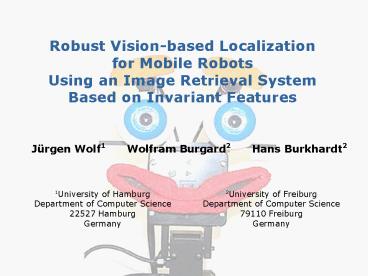Probabilistic Mapping - PowerPoint PPT Presentation
Title:
Probabilistic Mapping
Description:
For each f(M) we compute a histogram of the corresponding image matrices. The global feature F(M) consists of the multi-dimensional histograms computed for all f(M) ... – PowerPoint PPT presentation
Number of Views:45
Avg rating:3.0/5.0
Title: Probabilistic Mapping
1
Robust Vision-based Localization for Mobile
Robots Using an Image Retrieval System Based on
Invariant Features
Jürgen Wolf1 Wolfram Burgard2 Hans
Burkhardt2
1University of Hamburg Department of Computer
Science 22527 Hamburg Germany
2University of Freiburg Department of Computer
Science 79110 Freiburg Germany
2
The Localization Problem
Ingemar Cox (1991) Using sensory information
to locate the robot in its environment is the
most fundamental problem to provide a mobile
robot with autonomous capabilities.
- Position tracking (bounded uncertainty)
- Global localization (unbounded uncertainty)
- Kidnapping (recovery from failure)
3
Vision-based Localization
- Cameras are low-cost sensors
- that provide a huge amount of information.
- Cameras are passive sensors that do not suffer
from interferences. - Populated environments are full of visual clues
that support localization (for their inhabitants).
4
Related Work in Vision-based Robot Localization
- Sophisticated matching techniques without
filteringBasri Rivlin, 95, Dudek Sim,
99, Dudek Zhang, 96, Kortenkamp Weymouth,
94, Paletta et al., 01, Winters et al., 00,
Lowe Little, 01 - Image retrieval techniques without
filteringKröse Bunschoten, 99, Matsumo et
al., 99, Ulrich Nourbakhsh, 00 - Monte-Carlo localization with ceiling
mosaicsDellaert et al., 99 - Monte-Carlo localization with pre-defined
landmarksLenser Veloso, 00
5
Key Idea
- Use standard techniques from image retrieval for
computing the similarity between query images and
reference images. - ? No assumptions about the structure of the
environment - Use Monte-Carlo localization to integrate
information over time. - ? Robustness
6
Image Retrieval
- Given Query image q and image database d.
- Goal Find the images in d that are most
similar to q.
7
Key Ideas of the System Used
- Features that are invariant wrt.
- rotation,
- translation, and
- limited scale.
- Each feature consists of a histogram of local
features.
Siggelkow Burkhardt, 98
8
Example of Image Retrieval
Siggelkow Burkhardt, 98
9
Another Example
Siggelkow Burkhardt, 98
10
Euclidean Transformations used to Compute Local
Features
- Consider Image
- and Euclidean transformations g?G
- with
11
Image Matrices
Let f(M) be an arbitrary complex-valued function
over pixel values. We compute an image matrix
12
Computing an Image Matrix
13
Computing an Image Matrixusing
14
Obtaining Invariant Features from Image Matrices
A feature F(M) is invariant wrt. to a group of
transformations G if F(gM) F(M)?g?G. For
each f(M) we compute a histogram of the
corresponding image matrices. The global
feature F(M) consists of the multi-dimensional
histograms computed for all f(M).
15
Example
16
Computing Global Features
F(M)
The global feature F(M) consists of the
multi-dimensional histograms computed for all
Tf(M).
17
Observations
- Functions f(M) with a local support preserve
information about neighboring pixels. - The histograms F(M) are invariant wrt. image
translations, rotations, and limited scale. - They are robust against distortions and overlap.
18
Computing Similarity
- To compute the similarity between a database
image d and a query image q we use the normalized
intersection operator
Advantage matching of partial views.
19
Typical Results for Robot Data
Query image
Most similar images
20
Integrating Retrieval Results and Monte-Carlo
Localization
- Extract visibility area for each reference image.
- Weigh the samples in a visibility area
proportional to the similarity measure.
21
Visibility Regions
22
Experiments
- 936 Images, 4MB, .6secs/image
- Trajectory of the robot
23
Odometry Information
24
Image Sequence
25
Resulting Trajectories
Position tracking
26
Resulting Trajectories
Global localization
27
Global Localization
28
Kidnapping the Robot
29
Localization Error
30
Robustness against Noise
31
Validation
In principle, the constraints imposed by the
visibility regions can be sufficient for robot
localization. Burgard et al. 96
32
Summary
- New approach to vision-based robot localization.
- It uses an image retrieval-system for comparing
images to reference images. - The features used are invariant to translations,
rotations and limited scale. - Combination with Monte-Carlo localization allows
the integration of measurements over time. - The system is able to robustly estimate the
position of the robot and to recover from
localization failures. - It can deal with dynamic environments and works
under serious noise in the odometry.
33
Future Work
- Learning the optimal features for the retrieval
process. - Better exploitation of the visibility areas.
- Identifying important image regions.
34
Thanks ...
... and goodbye!































